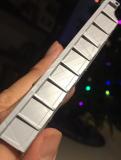
| Home | Open Account | Help | 309 users online |
|
Member Login
Discussion
Media SharingHostingLibrarySite Info |
Model Railroading > 3D Printer (Part 14) – Temperature LinesDate: 02/14/20 00:04 3D Printer (Part 14) – Temperature Lines Author: tmotor This is Part 14 of a series on my recent experience with an Anycubic “Photon S” 3D printer. (Parts 1 thru 13 were posted earlier.)
Lines There are some instances where visible surface lines in a part are acceptable. If it is the underside of a boxcar, or a jig to position components during assembly, then layer lines may be okay. However, for most finished parts, visible lines are a deal-breaker. The benchmark is a plastic injection molded part, which, of course, is free of unwanted layer lines. My first parts had horizontal layer lines, but I assumed they were “internal” since the resin is translucent. After a coat of primer, the surface would be glass smooth. NOT! The lines were not inside the resin wall, but were on the surface. Dhooooo! Well, there must be some parameter I can adjust to eliminate them. The most obvious one was temperature. The fans in the printer blow the resin fumes into the room, so I have mine in the garage. It gets down to 55 degrees at night. The resin thickens at these temps, so that is probably the issue. The label on the resin bottle states 77F (25C) as the recommended temperature, and I am well below that. I purchased a small heater to place next to the printer. A large cardboard box was placed over the top to create a shroud to retain the heat. (It wasn’t going to win any awards, but it did work.) The heater would cycle about every 30 minutes. The Vat was kept a toasty 80F+. Isolation The heater’s fan does produce some vibration when it is running. Assuming the printing process would be sensitive to this, a separate shelf was constructed that was not physically attached to the cabinet upon which the printer sat. This ensured the printer never felt the fan’s vibrations. (There are heaters with parabolic dish shapes that project the heat, rather than use a fan motor to move the heat via forced air. They tend to only come in larger sizes, and were overkill for my purposes; as well as being more expensive.) Deflection Upon inspecting the finished part, it showed the layer lines had diminished somewhat, but to my great disappointment an additional set of lines had appeared. I noticed they were in a pattern parallel to the FEP, about 1/4" apart. Turns out that when the heater fan engaged, it was blowing 150F air toward the printer. This heated the outside of the enclosure, which then heated not only the resin, but the metal support arms holding the Build Plate. Though the temperature rise was only about 15 degrees or so, it was enough to deflect the Build Plate, which translated into the periodic line pattern. The solution was to get an electric blanket, and wrap the printer. So now, the heater is used to bring the resin (and printer) up to temperature. The heater is then turned off, the print started, and the electric blanket maintains the temperature. Thankfully, this did eliminate the lines caused by the rapid rise in temperature. (High-end 3D resin printers have built-in heaters to keep the interior of the printer at a constant temperature. I now see that is not just an up-sell, but an important feature.) I did observe that the Vat was at a higher temperature (by 10 degrees) than the outside of the printer enclosure, which is because the LEDs generate UV light that produces some heat. After throttling-back the electric blanket, the Vat was at a 80F+ sweet spot. Some Youtubers have suggested the specific resin I use (Siraya Tech BLU) is known to be quite thick, and they have had better results with the resin at 90F. I didn’t notice a significant difference in the layer lines at 90F, but try to keep the Vat temp above 80F just to be sure the resin is plenty fluid. FEP Tune-Up The FEP was recently replaced, and had probably stretched a bit after 2 prints. It was registering 273Hz on the DrumTunerEZ app. One round of ¼-turns on the bolts brought it up to 337Hz, which was closer to where it was before. A FEP that is too loose could cause layer lines. I wanted to eliminate as many possible sources of unwanted lines as possible.  |